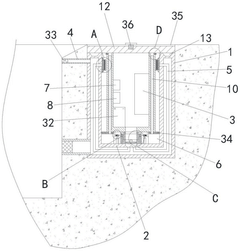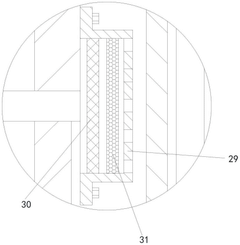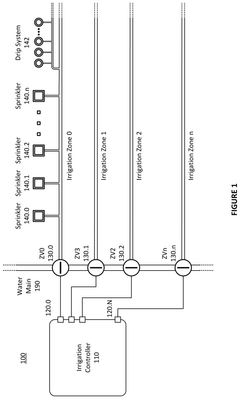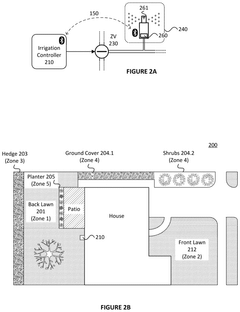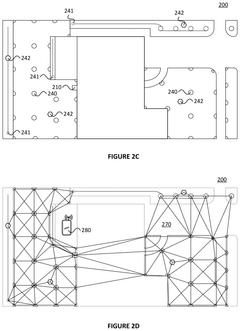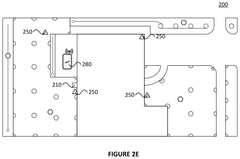How 5G UC Enhances the Efficiency of Smart Irrigation Systems
JUL 18, 20259 MIN READ
Generate Your Research Report Instantly with AI Agent
Patsnap Eureka helps you evaluate technical feasibility & market potential.
5G UC Smart Irrigation Background and Objectives
The convergence of 5G Ultra-Capacity (UC) technology and smart irrigation systems represents a significant leap forward in agricultural efficiency and sustainability. This integration addresses the pressing need for optimized water management in agriculture, a sector that consumes approximately 70% of the world's freshwater resources. The evolution of irrigation techniques has progressed from manual methods to automated systems, and now, with the advent of 5G UC, we are entering an era of unprecedented precision and control.
The primary objective of incorporating 5G UC into smart irrigation systems is to enhance water use efficiency while maximizing crop yield. This technology aims to provide real-time, high-resolution data on soil moisture, weather conditions, and plant health, enabling farmers to make informed decisions about when and how much to irrigate. The ultra-low latency and high bandwidth of 5G UC networks allow for the seamless integration of a vast array of sensors, actuators, and data analytics platforms, creating a comprehensive and responsive irrigation ecosystem.
Historically, irrigation practices have been limited by the capabilities of communication networks. Traditional cellular networks often struggle with the scale and speed required for effective smart irrigation, particularly in rural areas. 5G UC technology overcomes these limitations, offering speeds up to 100 times faster than 4G LTE and supporting up to 1 million connected devices per square kilometer. This capacity is crucial for deploying dense networks of soil sensors, weather stations, and automated irrigation systems across large agricultural areas.
The trend towards precision agriculture has set the stage for 5G UC smart irrigation. As farmers face increasing pressure to produce more food with fewer resources, the need for data-driven farming practices has never been more critical. 5G UC enables the implementation of edge computing in agricultural settings, allowing for rapid processing of vast amounts of data directly in the field. This capability supports real-time decision-making and automated responses to changing environmental conditions.
Furthermore, the integration of 5G UC with smart irrigation systems aligns with global sustainability goals. By optimizing water usage, this technology can significantly reduce water waste, energy consumption, and the environmental impact of agricultural practices. It also has the potential to improve crop resilience to climate change by enabling more adaptive and responsive irrigation strategies.
As we look towards the future, the objectives of 5G UC smart irrigation extend beyond mere efficiency gains. The technology aims to facilitate a holistic approach to farm management, integrating irrigation with other aspects of agriculture such as pest control, fertilization, and harvesting. This interconnected system promises to revolutionize farming practices, leading to more sustainable, productive, and resilient agricultural ecosystems.
The primary objective of incorporating 5G UC into smart irrigation systems is to enhance water use efficiency while maximizing crop yield. This technology aims to provide real-time, high-resolution data on soil moisture, weather conditions, and plant health, enabling farmers to make informed decisions about when and how much to irrigate. The ultra-low latency and high bandwidth of 5G UC networks allow for the seamless integration of a vast array of sensors, actuators, and data analytics platforms, creating a comprehensive and responsive irrigation ecosystem.
Historically, irrigation practices have been limited by the capabilities of communication networks. Traditional cellular networks often struggle with the scale and speed required for effective smart irrigation, particularly in rural areas. 5G UC technology overcomes these limitations, offering speeds up to 100 times faster than 4G LTE and supporting up to 1 million connected devices per square kilometer. This capacity is crucial for deploying dense networks of soil sensors, weather stations, and automated irrigation systems across large agricultural areas.
The trend towards precision agriculture has set the stage for 5G UC smart irrigation. As farmers face increasing pressure to produce more food with fewer resources, the need for data-driven farming practices has never been more critical. 5G UC enables the implementation of edge computing in agricultural settings, allowing for rapid processing of vast amounts of data directly in the field. This capability supports real-time decision-making and automated responses to changing environmental conditions.
Furthermore, the integration of 5G UC with smart irrigation systems aligns with global sustainability goals. By optimizing water usage, this technology can significantly reduce water waste, energy consumption, and the environmental impact of agricultural practices. It also has the potential to improve crop resilience to climate change by enabling more adaptive and responsive irrigation strategies.
As we look towards the future, the objectives of 5G UC smart irrigation extend beyond mere efficiency gains. The technology aims to facilitate a holistic approach to farm management, integrating irrigation with other aspects of agriculture such as pest control, fertilization, and harvesting. This interconnected system promises to revolutionize farming practices, leading to more sustainable, productive, and resilient agricultural ecosystems.
Market Demand Analysis for Smart Irrigation
The market demand for smart irrigation systems has been steadily increasing in recent years, driven by several key factors. Water scarcity and the need for sustainable agricultural practices have become pressing concerns worldwide, pushing farmers and agricultural businesses to adopt more efficient irrigation methods. Smart irrigation systems, enhanced by 5G UC technology, offer a promising solution to these challenges.
The global smart irrigation market is experiencing significant growth, with projections indicating continued expansion in the coming years. This growth is fueled by the increasing awareness of water conservation, government initiatives promoting sustainable agriculture, and the rising adoption of Internet of Things (IoT) technologies in farming practices. The integration of 5G UC into smart irrigation systems is expected to further accelerate market demand due to its ability to provide ultra-reliable, low-latency communication and massive machine-type communications.
In the agricultural sector, there is a growing need for precision farming techniques that can optimize water usage and improve crop yields. Smart irrigation systems equipped with 5G UC capabilities can offer real-time monitoring and control of water distribution, allowing farmers to make data-driven decisions and reduce water waste. This technology is particularly valuable in regions facing water scarcity or drought conditions, where efficient water management is crucial for maintaining agricultural productivity.
The market demand for 5G-enabled smart irrigation systems extends beyond traditional agriculture. Urban green spaces, golf courses, and large-scale landscaping projects are also potential markets for this technology. These sectors are increasingly looking for ways to reduce water consumption while maintaining the health and appearance of their green areas.
Another factor driving market demand is the potential for cost savings. While the initial investment in smart irrigation systems may be higher than traditional methods, the long-term benefits in terms of reduced water usage, lower labor costs, and improved crop yields make them an attractive option for many agricultural businesses. The enhanced efficiency provided by 5G UC technology can further amplify these cost-saving benefits, making the systems even more appealing to potential adopters.
The market for smart irrigation is also being influenced by changing consumer preferences and regulatory pressures. Consumers are becoming more environmentally conscious and are demanding sustainably produced food. This trend is pushing farmers and agricultural companies to adopt water-efficient practices, including smart irrigation systems. Additionally, governments and regulatory bodies in many countries are implementing stricter water management policies, creating a regulatory environment that favors the adoption of smart irrigation technologies.
As the technology continues to evolve and become more accessible, the market demand for 5G UC-enhanced smart irrigation systems is expected to grow across various agricultural sectors and geographical regions. This growth presents significant opportunities for technology providers, agricultural equipment manufacturers, and service providers in the smart irrigation ecosystem.
The global smart irrigation market is experiencing significant growth, with projections indicating continued expansion in the coming years. This growth is fueled by the increasing awareness of water conservation, government initiatives promoting sustainable agriculture, and the rising adoption of Internet of Things (IoT) technologies in farming practices. The integration of 5G UC into smart irrigation systems is expected to further accelerate market demand due to its ability to provide ultra-reliable, low-latency communication and massive machine-type communications.
In the agricultural sector, there is a growing need for precision farming techniques that can optimize water usage and improve crop yields. Smart irrigation systems equipped with 5G UC capabilities can offer real-time monitoring and control of water distribution, allowing farmers to make data-driven decisions and reduce water waste. This technology is particularly valuable in regions facing water scarcity or drought conditions, where efficient water management is crucial for maintaining agricultural productivity.
The market demand for 5G-enabled smart irrigation systems extends beyond traditional agriculture. Urban green spaces, golf courses, and large-scale landscaping projects are also potential markets for this technology. These sectors are increasingly looking for ways to reduce water consumption while maintaining the health and appearance of their green areas.
Another factor driving market demand is the potential for cost savings. While the initial investment in smart irrigation systems may be higher than traditional methods, the long-term benefits in terms of reduced water usage, lower labor costs, and improved crop yields make them an attractive option for many agricultural businesses. The enhanced efficiency provided by 5G UC technology can further amplify these cost-saving benefits, making the systems even more appealing to potential adopters.
The market for smart irrigation is also being influenced by changing consumer preferences and regulatory pressures. Consumers are becoming more environmentally conscious and are demanding sustainably produced food. This trend is pushing farmers and agricultural companies to adopt water-efficient practices, including smart irrigation systems. Additionally, governments and regulatory bodies in many countries are implementing stricter water management policies, creating a regulatory environment that favors the adoption of smart irrigation technologies.
As the technology continues to evolve and become more accessible, the market demand for 5G UC-enhanced smart irrigation systems is expected to grow across various agricultural sectors and geographical regions. This growth presents significant opportunities for technology providers, agricultural equipment manufacturers, and service providers in the smart irrigation ecosystem.
5G UC Technology Status and Challenges
The current status of 5G UC (Ultra-Reliable and Low-Latency Communication) technology in smart irrigation systems is characterized by significant advancements and ongoing challenges. 5G UC has emerged as a promising solution for enhancing the efficiency of smart irrigation systems, offering ultra-low latency and high reliability that are crucial for real-time monitoring and control of agricultural operations.
In terms of technological progress, 5G UC has demonstrated remarkable capabilities in supporting smart irrigation systems. The technology enables near-instantaneous data transmission between sensors, actuators, and control centers, allowing for precise and timely irrigation decisions. This has led to substantial improvements in water usage efficiency and crop yield optimization.
However, the widespread implementation of 5G UC in smart irrigation systems faces several challenges. One of the primary obstacles is the limited coverage of 5G networks in rural and agricultural areas. The deployment of 5G infrastructure in these regions often lags behind urban centers, creating a digital divide that hinders the adoption of advanced irrigation technologies.
Another significant challenge is the integration of 5G UC with existing irrigation systems and agricultural practices. Many farms still rely on legacy equipment and traditional methods, making the transition to 5G-enabled smart irrigation systems complex and potentially costly. This integration process requires not only technological upgrades but also extensive training and adaptation for farmers and agricultural workers.
The power consumption of 5G UC devices in remote agricultural settings poses an additional challenge. While 5G technology offers improved energy efficiency compared to previous generations, the continuous operation of sensors and communication modules in large-scale irrigation systems can still strain power resources, especially in areas with limited access to reliable electricity.
Data security and privacy concerns also present challenges in the implementation of 5G UC for smart irrigation. The increased connectivity and data exchange in these systems create potential vulnerabilities to cyber attacks and unauthorized access to sensitive agricultural information. Ensuring robust security measures without compromising the performance and efficiency of the irrigation systems remains a critical challenge.
From a geographical perspective, the development and adoption of 5G UC technology for smart irrigation systems vary significantly across regions. Countries with advanced technological infrastructure and strong agricultural sectors, such as the United States, China, and parts of Europe, are at the forefront of implementing these systems. However, many developing nations, where agriculture plays a crucial role in the economy, are still in the early stages of exploring 5G UC applications in irrigation.
In conclusion, while 5G UC technology shows great promise in enhancing the efficiency of smart irrigation systems, its current status is characterized by a mix of impressive advancements and substantial challenges. Overcoming these obstacles will be crucial for realizing the full potential of 5G UC in revolutionizing agricultural practices and water management on a global scale.
In terms of technological progress, 5G UC has demonstrated remarkable capabilities in supporting smart irrigation systems. The technology enables near-instantaneous data transmission between sensors, actuators, and control centers, allowing for precise and timely irrigation decisions. This has led to substantial improvements in water usage efficiency and crop yield optimization.
However, the widespread implementation of 5G UC in smart irrigation systems faces several challenges. One of the primary obstacles is the limited coverage of 5G networks in rural and agricultural areas. The deployment of 5G infrastructure in these regions often lags behind urban centers, creating a digital divide that hinders the adoption of advanced irrigation technologies.
Another significant challenge is the integration of 5G UC with existing irrigation systems and agricultural practices. Many farms still rely on legacy equipment and traditional methods, making the transition to 5G-enabled smart irrigation systems complex and potentially costly. This integration process requires not only technological upgrades but also extensive training and adaptation for farmers and agricultural workers.
The power consumption of 5G UC devices in remote agricultural settings poses an additional challenge. While 5G technology offers improved energy efficiency compared to previous generations, the continuous operation of sensors and communication modules in large-scale irrigation systems can still strain power resources, especially in areas with limited access to reliable electricity.
Data security and privacy concerns also present challenges in the implementation of 5G UC for smart irrigation. The increased connectivity and data exchange in these systems create potential vulnerabilities to cyber attacks and unauthorized access to sensitive agricultural information. Ensuring robust security measures without compromising the performance and efficiency of the irrigation systems remains a critical challenge.
From a geographical perspective, the development and adoption of 5G UC technology for smart irrigation systems vary significantly across regions. Countries with advanced technological infrastructure and strong agricultural sectors, such as the United States, China, and parts of Europe, are at the forefront of implementing these systems. However, many developing nations, where agriculture plays a crucial role in the economy, are still in the early stages of exploring 5G UC applications in irrigation.
In conclusion, while 5G UC technology shows great promise in enhancing the efficiency of smart irrigation systems, its current status is characterized by a mix of impressive advancements and substantial challenges. Overcoming these obstacles will be crucial for realizing the full potential of 5G UC in revolutionizing agricultural practices and water management on a global scale.
Current 5G UC Solutions for Smart Irrigation
01 Network resource allocation and optimization
5G UC efficiency can be improved through intelligent allocation and optimization of network resources. This includes dynamic spectrum sharing, adaptive beamforming, and advanced scheduling algorithms to maximize capacity and minimize latency. These techniques allow for more efficient use of available bandwidth and improved overall network performance.- Network resource allocation and optimization: 5G UC efficiency can be improved through intelligent allocation and optimization of network resources. This includes dynamic spectrum management, adaptive beamforming, and load balancing techniques to maximize capacity and coverage. Advanced algorithms are employed to optimize resource utilization based on real-time network conditions and user demands.
- Advanced antenna technologies: Implementation of advanced antenna technologies such as Massive MIMO (Multiple-Input Multiple-Output) and beamforming significantly enhances 5G UC efficiency. These technologies enable more focused and directional signal transmission, improving signal quality, reducing interference, and increasing overall network capacity.
- Network slicing and virtualization: Network slicing and virtualization techniques allow for the creation of multiple virtual networks on a single physical infrastructure. This enables efficient allocation of resources to different services and use cases, optimizing the overall performance and efficiency of 5G UC networks.
- Edge computing integration: Integrating edge computing capabilities with 5G UC networks reduces latency and improves overall efficiency. By processing data closer to the source, network congestion is reduced, and response times are improved, leading to enhanced performance for latency-sensitive applications and services.
- AI-driven network optimization: Artificial Intelligence (AI) and Machine Learning (ML) algorithms are employed to continuously optimize 5G UC network performance. These technologies enable predictive maintenance, automated network management, and real-time optimization of network parameters, resulting in improved efficiency and user experience.
02 Advanced antenna technologies
Implementation of advanced antenna technologies such as Massive MIMO (Multiple-Input Multiple-Output) and beamforming can significantly enhance 5G UC efficiency. These technologies enable more focused and directional signal transmission, resulting in improved coverage, capacity, and energy efficiency in ultra-capacity networks.Expand Specific Solutions03 Edge computing and network slicing
Leveraging edge computing and network slicing techniques can optimize 5G UC efficiency. By processing data closer to the source and creating virtual network segments tailored to specific use cases, these approaches reduce latency, improve resource utilization, and enhance overall network performance for ultra-capacity scenarios.Expand Specific Solutions04 AI and machine learning integration
Incorporating artificial intelligence and machine learning algorithms into 5G UC networks can enhance efficiency through predictive analytics, automated network optimization, and intelligent traffic management. These technologies enable networks to adapt in real-time to changing conditions and user demands, maximizing ultra-capacity utilization.Expand Specific Solutions05 Energy-efficient hardware and protocols
Developing and implementing energy-efficient hardware components and communication protocols can improve the overall efficiency of 5G UC networks. This includes low-power radio frequency (RF) components, energy-aware routing algorithms, and sleep mode optimizations for network elements during periods of low activity.Expand Specific Solutions
Key Players in 5G UC and Smart Irrigation
The 5G UC (Ultra Capacity) technology for smart irrigation systems is in an early growth stage, with significant potential for market expansion. The global smart irrigation market is projected to reach $2.9 billion by 2027, driven by water scarcity concerns and agricultural efficiency needs. While 5G UC technology is still emerging in this sector, its integration is accelerating due to its ability to enhance data transmission and real-time control. Key players like Nokia, IBM, and Samsung are at the forefront of developing 5G-enabled smart irrigation solutions, leveraging their expertise in telecommunications and IoT. Universities such as Northwest A&F University and North China University of Water Resources and Electric Power are contributing to research and development in this field, indicating a growing focus on academic-industry collaboration to advance the technology.
Nokia Solutions & Networks Oy
Technical Solution: Nokia's 5G UC solution for smart irrigation focuses on creating a comprehensive end-to-end network infrastructure tailored for agricultural applications. Their approach leverages Nokia's expertise in 5G network slicing to create dedicated, low-latency communication channels for critical irrigation control systems. The solution incorporates Nokia's Digital Automation Cloud platform, which enables edge computing capabilities directly at the farm site. This allows for real-time processing of sensor data and rapid response to changing conditions. Nokia's system utilizes a combination of low-power wide-area network (LPWAN) technologies alongside 5G UC to ensure comprehensive coverage across large agricultural areas. Their solution also includes advanced analytics tools that process data from various sources, including satellite imagery, drone surveys, and ground-based sensors, to create highly accurate soil moisture maps and crop health assessments[8][10].
Strengths: Extensive experience in telecommunications infrastructure, strong capabilities in network optimization and management. Weaknesses: Less direct experience in agricultural technology, potential challenges in integrating with specialized farming equipment.
International Business Machines Corp.
Technical Solution: IBM's 5G UC-enhanced smart irrigation solution leverages their expertise in AI, cloud computing, and IoT. Their approach integrates the IBM Watson IoT platform with 5G-connected sensors and irrigation control systems. The solution utilizes 5G UC's high-speed, low-latency connectivity to enable real-time data streaming from a dense network of soil moisture sensors, weather stations, and crop monitoring devices. IBM's system employs edge computing nodes to process data locally, reducing latency for critical decisions. The core of their solution is an AI-driven predictive model that combines historical data, real-time sensor inputs, and weather forecasts to optimize irrigation schedules. This model continuously learns and adapts, improving water use efficiency over time. IBM's platform also incorporates blockchain technology to ensure data integrity and traceability in water management[7][9].
Strengths: Advanced AI and data analytics capabilities, robust cloud infrastructure, and experience in large-scale system integration. Weaknesses: Potential high costs for small-scale farmers, complexity in implementation and maintenance.
Core Innovations in 5G UC for Irrigation
An embedded fertilization and irrigation controller based on 5G signals
PatentActiveCN115379697B
Innovation
- An embedded fertilization and irrigation controller based on 5G signals is designed. By embedding the control box in the fixed box, using the sealing cover and sealing ring to prevent dust and water from entering, combined with a cooling fan for cooling, and installing 5G wireless in the control box The communication module performs remote data transmission and control.
Intelligent irrigation system component
PatentPendingUS20250146468A1
Innovation
- The development of a smart irrigation system that utilizes RF communication, energy harvesting, and a mesh network to enable efficient control and power distribution to sprinklers and other irrigation elements, allowing for real-time data collection and adaptive water management.
Environmental Impact and Sustainability
The integration of 5G UC technology with smart irrigation systems presents significant potential for enhancing environmental sustainability in agriculture. By enabling more precise and efficient water management, these advanced systems can substantially reduce water consumption while maintaining or even improving crop yields. This reduction in water usage is particularly crucial in regions facing water scarcity or drought conditions, helping to conserve this vital resource for future generations.
Furthermore, the improved efficiency of smart irrigation systems powered by 5G UC can lead to a decrease in energy consumption associated with water pumping and distribution. This reduction in energy use translates to lower greenhouse gas emissions, contributing to overall climate change mitigation efforts in the agricultural sector. The real-time monitoring and control capabilities facilitated by 5G UC also allow for more targeted application of fertilizers and pesticides, minimizing runoff and potential contamination of nearby water sources.
The enhanced data collection and analysis capabilities enabled by 5G UC in smart irrigation systems can contribute to more sustainable land use practices. By providing farmers with detailed insights into soil moisture levels, weather patterns, and crop health, these systems support data-driven decision-making that can optimize resource allocation and reduce environmental impact. This precision agriculture approach can help minimize soil erosion, preserve soil health, and maintain biodiversity in agricultural landscapes.
Moreover, the implementation of 5G UC-enhanced smart irrigation systems can play a role in promoting sustainable farming practices on a broader scale. By demonstrating the economic and environmental benefits of precision water management, these systems can encourage wider adoption of sustainable agricultural techniques. This shift towards more environmentally conscious farming methods can have far-reaching effects on ecosystem health, water conservation, and climate resilience.
The long-term environmental benefits of implementing 5G UC in smart irrigation systems extend beyond immediate resource conservation. By enabling more efficient and sustainable agricultural practices, these systems can contribute to food security while reducing the overall environmental footprint of food production. This aligns with global sustainability goals and supports the transition towards more resilient and eco-friendly agricultural systems capable of meeting the challenges of a changing climate and growing global population.
Furthermore, the improved efficiency of smart irrigation systems powered by 5G UC can lead to a decrease in energy consumption associated with water pumping and distribution. This reduction in energy use translates to lower greenhouse gas emissions, contributing to overall climate change mitigation efforts in the agricultural sector. The real-time monitoring and control capabilities facilitated by 5G UC also allow for more targeted application of fertilizers and pesticides, minimizing runoff and potential contamination of nearby water sources.
The enhanced data collection and analysis capabilities enabled by 5G UC in smart irrigation systems can contribute to more sustainable land use practices. By providing farmers with detailed insights into soil moisture levels, weather patterns, and crop health, these systems support data-driven decision-making that can optimize resource allocation and reduce environmental impact. This precision agriculture approach can help minimize soil erosion, preserve soil health, and maintain biodiversity in agricultural landscapes.
Moreover, the implementation of 5G UC-enhanced smart irrigation systems can play a role in promoting sustainable farming practices on a broader scale. By demonstrating the economic and environmental benefits of precision water management, these systems can encourage wider adoption of sustainable agricultural techniques. This shift towards more environmentally conscious farming methods can have far-reaching effects on ecosystem health, water conservation, and climate resilience.
The long-term environmental benefits of implementing 5G UC in smart irrigation systems extend beyond immediate resource conservation. By enabling more efficient and sustainable agricultural practices, these systems can contribute to food security while reducing the overall environmental footprint of food production. This aligns with global sustainability goals and supports the transition towards more resilient and eco-friendly agricultural systems capable of meeting the challenges of a changing climate and growing global population.
Regulatory Framework for 5G in Agriculture
The regulatory framework for 5G in agriculture is a critical aspect of implementing advanced technologies in the farming sector. As 5G networks continue to expand, governments and regulatory bodies are developing policies to ensure the safe and effective use of this technology in agricultural applications, including smart irrigation systems.
In many countries, telecommunications regulatory agencies are working closely with agricultural departments to create guidelines for 5G deployment in rural areas. These guidelines often address issues such as spectrum allocation, infrastructure sharing, and rural connectivity requirements. For instance, some regulators have set aside specific frequency bands for agricultural use, ensuring that smart farming applications have dedicated and interference-free access to 5G networks.
Environmental regulations also play a significant role in shaping the 5G landscape for agriculture. As smart irrigation systems become more prevalent, water management authorities are updating their policies to accommodate these new technologies. This includes regulations on water usage monitoring, data collection, and reporting requirements for farms utilizing 5G-enabled irrigation systems.
Data privacy and security regulations are another crucial component of the 5G regulatory framework in agriculture. With the increased connectivity and data generation from smart irrigation systems, farmers must comply with data protection laws. These regulations often mandate secure data storage, transmission protocols, and user consent mechanisms for collecting and sharing farm-related information.
Standardization efforts are underway to ensure interoperability and compatibility between different 5G-enabled agricultural technologies. Industry bodies and standards organizations are developing protocols for communication between smart irrigation systems, sensors, and other farm equipment. These standards aim to create a cohesive ecosystem that allows farmers to integrate various technologies seamlessly.
Regulatory bodies are also addressing the potential health and environmental impacts of 5G technology in agricultural settings. This includes guidelines for the placement of 5G infrastructure on farmland, electromagnetic field exposure limits for workers and livestock, and environmental impact assessments for large-scale deployments.
As the technology evolves, regulators are adopting adaptive approaches to keep pace with innovations in 5G and smart farming. Many countries have established regulatory sandboxes or pilot programs to test new applications of 5G in agriculture under controlled conditions. These initiatives allow for real-world testing of smart irrigation systems and other technologies while providing valuable insights for future policy development.
In many countries, telecommunications regulatory agencies are working closely with agricultural departments to create guidelines for 5G deployment in rural areas. These guidelines often address issues such as spectrum allocation, infrastructure sharing, and rural connectivity requirements. For instance, some regulators have set aside specific frequency bands for agricultural use, ensuring that smart farming applications have dedicated and interference-free access to 5G networks.
Environmental regulations also play a significant role in shaping the 5G landscape for agriculture. As smart irrigation systems become more prevalent, water management authorities are updating their policies to accommodate these new technologies. This includes regulations on water usage monitoring, data collection, and reporting requirements for farms utilizing 5G-enabled irrigation systems.
Data privacy and security regulations are another crucial component of the 5G regulatory framework in agriculture. With the increased connectivity and data generation from smart irrigation systems, farmers must comply with data protection laws. These regulations often mandate secure data storage, transmission protocols, and user consent mechanisms for collecting and sharing farm-related information.
Standardization efforts are underway to ensure interoperability and compatibility between different 5G-enabled agricultural technologies. Industry bodies and standards organizations are developing protocols for communication between smart irrigation systems, sensors, and other farm equipment. These standards aim to create a cohesive ecosystem that allows farmers to integrate various technologies seamlessly.
Regulatory bodies are also addressing the potential health and environmental impacts of 5G technology in agricultural settings. This includes guidelines for the placement of 5G infrastructure on farmland, electromagnetic field exposure limits for workers and livestock, and environmental impact assessments for large-scale deployments.
As the technology evolves, regulators are adopting adaptive approaches to keep pace with innovations in 5G and smart farming. Many countries have established regulatory sandboxes or pilot programs to test new applications of 5G in agriculture under controlled conditions. These initiatives allow for real-world testing of smart irrigation systems and other technologies while providing valuable insights for future policy development.
Unlock deeper insights with Patsnap Eureka Quick Research — get a full tech report to explore trends and direct your research. Try now!
Generate Your Research Report Instantly with AI Agent
Supercharge your innovation with Patsnap Eureka AI Agent Platform!
